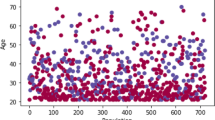Abstract
Diabetes Mellitus affects adults and children, causing changes in lifestyle. The diabetic affected person count has increased drastically worldwide over the last few years; about 425 million people have diabetes. By 2030, it is predicted that diabetic disorder will be the seventh leading cause of human death. Diabetes mellitus is measured invasively. This method has limitations such as patient’s preparation, piercing of the skin, which causes infection and needs for skilled technicians. In order to avoid the limitations of invasive methods, vibrations from the pancreas are acquired using a smartphone accelerometer sensor and detecting the value of diabetes. The human body has a unique energy signature for every organ, which leads to vibrations with different frequencies. The frequency of the vibration signal from the pancreas is proportional to insulin secretion and dynamics. The signals obtained from the accelerometer sensor are trained and analyzed with the Levenberg–Marquardt algorithm for obtaining the relation between the excess insulin secretion and clinical value of the diabetic level of the person. The accelerometer signals and clinical values are modeled with Regression analysis for the diabetic and non-diabetic persons. The results show the correlation between the fluid dynamics of insulin and clinical value at about 95% in prediction.





Similar content being viewed by others
Change history
04 July 2022
This article has been retracted. Please see the Retraction Notice for more detail: https://doi.org/10.1007/s12652-022-04255-4
Reference
Athavale J, Joshi Y, Yoda M (2018) Artificial neural network based prediction of temperature and flow profile in data centres. In: 17th IEEE intersociety conference on thermal and thermomechanical phenomena in electronic systems, pp 871–880
Buda RA, Addi MM (2014) A portable non-invasive blood glucose monitoring device. IEEE Conference on Biomedical Engineering and Sciences, pp 964–969
Chuo Y, Marzencki M, Hung B, Jaggernauth C, Tavakolian K, Lin P, Kaminska B (2010) Mechanically flexible wireless multisensory platform for human physical activity and vitals monitoring. IEEE Trans Biomed Circuits Syst 4(5):281–294
Devikanniga D, Samual Raj RJ (2017) Classification of osteoporosis by artificial neural network based on monarch butterfly optimization algorithm. Healthc Technol Lett 5(2):70–75
Fatemi M, Manduca A, Greenleaf JF (2003) Imaging elastic properties of biological tissues by low-frequency harmonic vibration. Proc IEEE 91(10):1503–1518
Gao Y (2020) The application of artificial neural network in watch modeling design with network community media. J Ambient Intell Hum Comput. https://doi.org/10.1007/s12652-020-01689-6
Jayalakshmi T, Santhakumaran A (2010) A novel classification method for diagnosis of diabetes mellitus using artificial neural network. In: International conference on data storage and data engineering, pp 159–162
Jia W, Li Y, Bai Y, Mao Z-H, Sun M (2015) Estimation of heart rate from a chest-worn inertial measurement unit. In: International symposium on bioelectronics and bioinformatics, pp 148–151
Joshi S, Borse M (2016) Detection and prediction of diabetes mellitus using back-propagation neural network. In: International conference on micro-electronics and telecommunication engineering, pp 110–113
Katbay Z, Mokdad SA, Sadek S, Le Roy M, Lababidi R, Perennec A (2017) A UWB Antenna in direct breast contact for cancer detection. Sensors Networks Smart and Emerging Technologies
Liu J, Wang P, Tian X (2017) Vibration displacement measurement based on three axes accelerometer. In: Chinese Automation Congress, pp 2374–2377
Liu B (2019) Research on anti-glycation activity based on dynamic particle swarm optimization for BP neural network. J Intell Fuzzy Systems 37(3):3103–3112
Mortajez S, Jamshidinezhad A (2019) An artificial neural network model to diagnosis of type II diabetes. J Res Med Dental Sci 7(1):66–70
Qin Y et al (2019) Relationship between random blood glucose, fasting blood glucose, and gensini score in patients with acute myocardial infarction. BioMed Res Int 2019:1–9
Rendon DB, Ojeda JLR, CrespoFoix LF, Morillo DS, Fernandez MA (2007) Mapping the human body for vibrations using an Accelerometer. In: 29 Annual international conference of the IEEE engineering in medicine and biology society, pp 1671–1674
Rossi A, Orsini F, Scorza A, Botta F, Sciuto SA, Di Giminiani R (2016) A preliminary characterization of a whole body vibration platform prototype for medical and rehabilitation application. In: IEEE International Symposium on Medical Measurements and Applications
Sawada H, Nakamura Y, Takeda Y, Uchida K (2013) Micro-vibration array using SMA actuators for the screening of diabetes. In: 6th International conference on human system interactions, pp 620–625
Thompson WR, Yen SS, Rubin J (2015) Vibration therapy: clinical applications in bone. Curr Opin Endocrinol Diabetes Obes 21(6):447–453
Wehrle E et al (2014) The impact of low-magnitude high-frequency vibration on fracture healing is profoundly influenced by the oestrogen status in mice. 93–104
Weinheimer-Haus EM, Judex S, Ennis WJ, Koh TJ (2014) Low-intensity vibration improves Angiogenesis and wound healing in diabetic mice. PLOS ONE 9(3):1–8
Yu COL et al (2017) Low-magnitude high-frequency vibration accelerated the foot wound healing of n5-streptozotocin-induced diabetic rats by enhancing glucose transporter 4 and microcirculation. Sci Rep Nat 7:1–12
Author information
Authors and Affiliations
Corresponding author
Additional information
Publisher's Note
Springer Nature remains neutral with regard to jurisdictional claims in published maps and institutional affiliations.
This article has been retracted. Please see the retraction notice for more detail: https://doi.org/10.1007/s12652-022-04255-4
About this article
Cite this article
Arul Kumar, D., Jayanthy, T. RETRACTED ARTICLE: Application of back propagation artificial neural network in detection and analysis of diabetes mellitus. J Ambient Intell Human Comput 12, 7063–7070 (2021). https://doi.org/10.1007/s12652-020-02371-7
Received:
Accepted:
Published:
Issue Date:
DOI: https://doi.org/10.1007/s12652-020-02371-7




